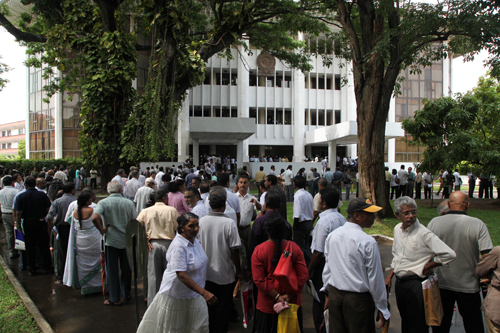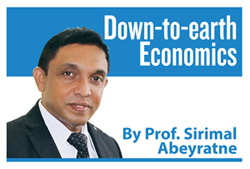Cry of the savers
View(s):
File picture of depositors, mostly retirees living on interest income, of a failed finance company outside the Supreme Court many years ago where their case was being heard.
For us – the retirees, the deposit interest rates have been cut down by half so that we have to go begging in our old age to live a life beyond ‘parippu and pol sambol’.” I didn’t exaggerate, but it was exactly the harsh statement of an angered retiree whom I came across recently. And it was the result of cruel policies of the Central Bank, according to his interpretation. And it is not the view of a random individual either; it is the common voice of many elderly people who maintained bank savings.
People who used to live on interest incomes from their savings and fixed deposits have been hit hard by the sharp fall in interest rates over the past 12 months! As the interest rates on savings have fallen from about 10 per cent in early 2020 to less than 5 per cent by now, the interest incomes of the savers have also declined by about 50 per cent. Probably, the most vulnerable segment has been the elderly people including retirees who used to live on interest incomes of their savings.
To make matters worse, Sri Lanka is one of the countries with a high ageing population. Within a period of 50 years from 1963 to 2012, people over 60 years of age will have increased from 600,000 to 2.5 million. In a society which has not been able to establish a proper social security system and a national health insurance scheme for its senior citizens, the adversary of the ageing problem is outstanding. Thus, living on interest incomes at the latter part of life is the hope of at least some of the elderly people who are faced with shrinking opportunities.
Bad news
For today’s discussion in this column, I am taking this issue – fall of interest rates. However, it is not my intention to dig into the pain of the elderly and the retirees who got affected by the falling interest rates and to present the solutions to the problem; in fact, it cannot be solved through interest rate. I will return to this problem too at the end of this discussion. Rather my focus is on the economic realities of interest rate behaviour.
At the outset, I have bad news: If we are used to live on interest income of savings, it is a result of an “economic problem” of the country. Well, I don’t think it is unusual to find someone taking advantage of another’s problem; it happens everywhere and all the time. What I meant is that even living on interest incomes is no different from that.
Let me go back to history. During the early years of the banking system, people who deposited their money, actually paid to the banks for keeping their money safe. When the banks realised that all their customers who keep money with them do not return together to withdraw their deposits, the banks could use their idling money to lend to some others and earn interest. Then the banks also decided to give depositors part of the interest they earn from lending as an incentive to attract more deposits.
As a result, today we have modern banking systems which pay interest on savings and charge interest on lending; the difference between the two interest rates or the interest rate spread is the bank’s profit cum costs of protecting the deposited sum.
Low and flexible
When monetary policy became an important policy tool in the hand of the Central Bank to achieve the economic objectives, interest rates started to play an important role in the economy. These economic objectives are well known as “economic growth” and “price stability”. Apart from that, giving an “interest income to the depositors” is not an objective of the monetary policy!
 Under normal circumstances, the average interest rate has to be low and flexible. It has to be “lower” in order to keep the business environment attractive for private credit expansion and productive investment. Then the interest cost of borrowing is cheaper so that the banks can provide capital for businesses; and it supports economic growth. It has to be “flexible” too in order to be responsive to the changes in macroeconomic fundamentals, including inflation; this means it should not be manipulated. For this reason, interest rates move closely with the inflation rate. If the inflation rate is high, then interest rates rise; if the inflation rate is low, then the interest rate too falls.
Under normal circumstances, the average interest rate has to be low and flexible. It has to be “lower” in order to keep the business environment attractive for private credit expansion and productive investment. Then the interest cost of borrowing is cheaper so that the banks can provide capital for businesses; and it supports economic growth. It has to be “flexible” too in order to be responsive to the changes in macroeconomic fundamentals, including inflation; this means it should not be manipulated. For this reason, interest rates move closely with the inflation rate. If the inflation rate is high, then interest rates rise; if the inflation rate is low, then the interest rate too falls.
The Central Bank can use the interest rate as its policy tool, as and when the need arises. When there is inflationary pressure mounting in the economy (due to increased spending beyond the limits by people or the government), the interest rate is the tool at hand to arrest it. Then the Central Bank raises the interest rates and controls credit expansion, thereby controlling excessive spending. When there is no foreseeable inflationary pressure and there is a need for supporting credit expansion, then the Central Bank can push the interest rates down and increase money for credit expansion.
Time for lower interest rates
If we are clear about the role of the interest rate, then it must be clear why interest rates are that much lower now. There is an economic crisis locally as well as globally, which got aggravated due to the COVID-19 pandemic issue. As a result, businesses have got affected and economic growth slowed down. People lost incomes, jobs, and livelihoods. And there is neither inflationary pressure in the economy.
Therefore, it is time to support economic expansion with monetary policy stimulus – lower interest rates and more money for credit expansion. Through the monetary policy stimulus, it is expected to mitigate the recession impact on the economy. As long as we don’t see inflationary pressure building up again, the current low interest rate regime is likely to remain.
Compared to many of our neighbouring countries in Asia, Sri Lanka’s interest rates are still higher. The current key interest rate in Sri Lanka is 4.5 per cent, compared to 3.85 per cent in China, 4 per cent in India, 3.5 per cent in Indonesia, 1.75 per cent in Malaysia, 0.18 per cent in Singapore, 0.5 per cent in South Korea and 0.5 per cent in Thailand. The low interest rate regime in the context of depressed economic conditions and lower inflationary environment is the global scenario. If the domestic interest rates are not falling in line with those of the global economy, in fact, there is a problem.
What about depositors?
What about the lost incomes of our depositors and senior citizens? Well an economic answer to the problem is clear; if we anticipate our primary incomes from bank savings, it reflects a problem in the economy. And why we have learnt to depend on interest incomes from savings is because the issue has not been addressed where it should have been addressed.
In the first place, the primary income should be generated primarily from investments in productive activities or equity markets or capital markets. When these opportunities have not yet been developed, naturally we look for other ways of income generation opportunities such as bank savings. And it has also been encouraged due to high interest rates which existed for various reasons in the past. Of course, people do save money in the bank deposits for various purposes, not just for interest incomes.
What about the elderly? In the present welfare states, there is a strong social security system and a health insurance scheme. Although Sri Lanka has a long-standing reputation over its extensive welfare system, these essential elements have not yet been incorporated adequately into our welfare programmes.
Finally, mixing up the objectives is not a good strategy for proper economic management. Interest rates of a country should serve its primary purpose, while income generation and caring for the elderly should be addressed at their sources and not in the monetary policy.
(The writer is a Professor of Economics at the University of Colombo and can be reached at
sirimal@econ.cmb.ac.lk and follow on Twitter @SirimalAshoka).



